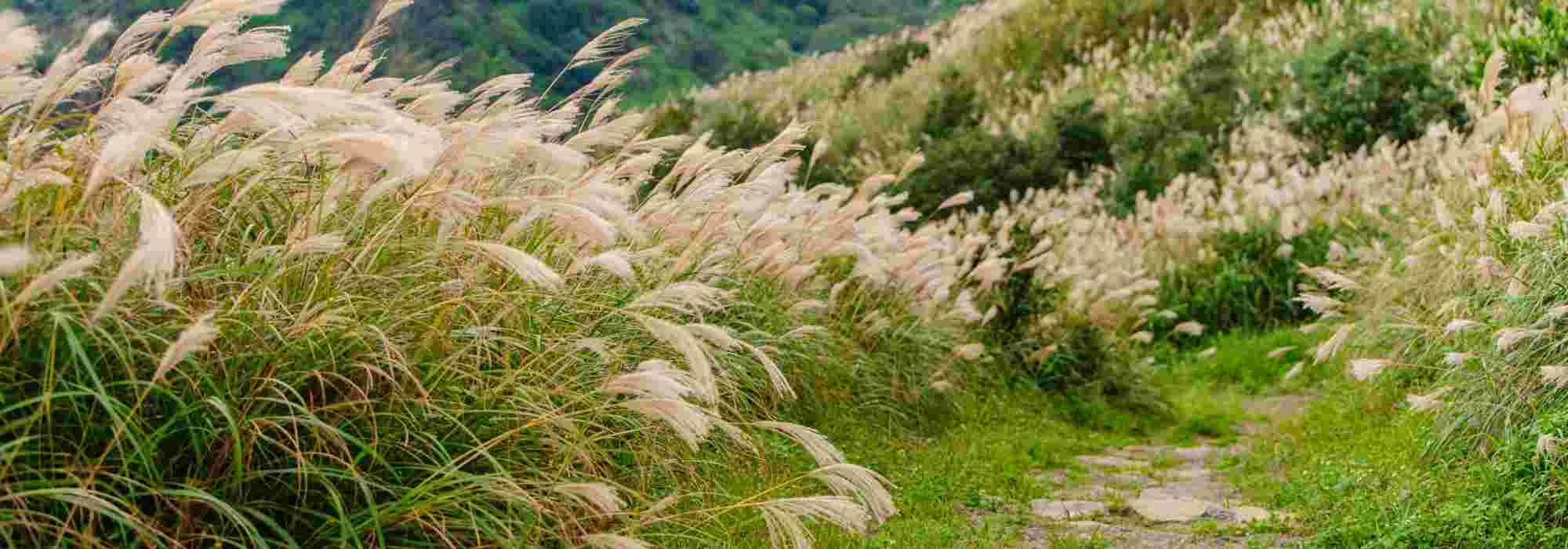
9 ideas for pairing Miscanthus
Invite Chinese reed into multiple garden compositions
Contents
Imposing, even majestic, the Miscanthus dress gardens almost all year with their highly decorative culms, graceful foliage and luminous flowering. They are among the favourite grasses you’ll use in a variety of sunny planting schemes. Their robustness, vigour and spectacular late-summer flowering are all reasons to plant them in different settings, where they always hit the mark: borders, natural meadow, “Winter garden”, dry garden, even by your garden pond!
Discover how to showcase Miscanthus in planting schemes where this grass of character commands attention.
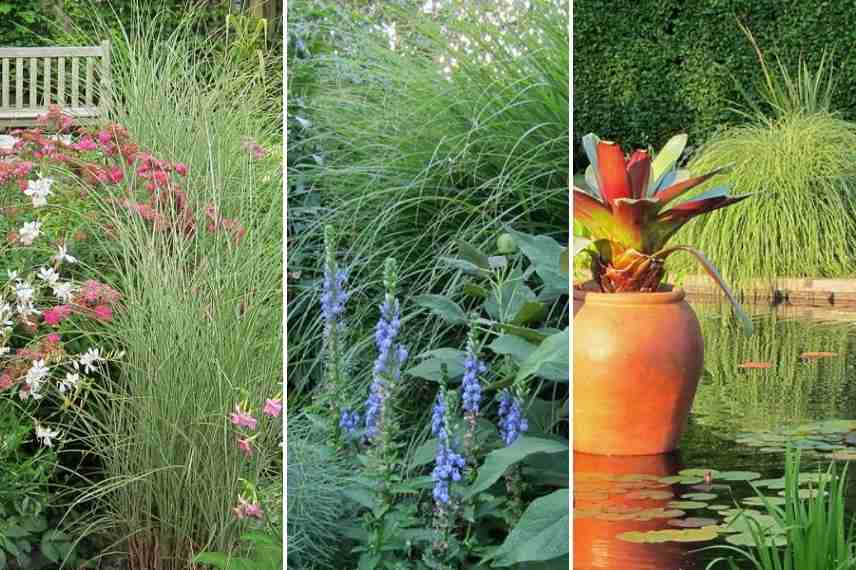
→ Also discover our guide to planting, pruning and care of Miscanthus and our wide range of Miscanthus
Mass planting
You can create magnificent borders with any Miscanthus; depending on variety and height, you will achieve completely different results. By choosing tall specimens, they become the structural plants of the border, yet their lightness does not steal the show from other plants:
Create pastoral scenes with a Miscanthus sinensis ‘Gracillimus’, accompanied by Chrisantemum Corinna, the romantic Alcalthaea ‘Parkallee’ with soft champagne hues, and the wild Verbascum ‘Southern Charm’.
In contemporary gardens or if you are seeking a more modern look, keep composition understated and play with greens: pair several clumps of large Miscanthus with spheres of boxwood or a low hedge of privet or Pittosporum tenuifolium ‘Midget’ clipped into an undulating shape, or even a series of cushions of Pittosporums tobira : the contrast of shapes, textures and dark green against the yellow of the inflorescences is simply beautiful!
For an exotic border, dare to mix exceptional foliage: Miscanthus sinensis ‘Gracillimus’ and the variegated Miscanthus sinensis ‘Strictus’ with the bluish tones of a Melianthus major, the mint-green and brown of a Phormium ‘Chocomint’, and the purple of Cannas ‘Durban’ !
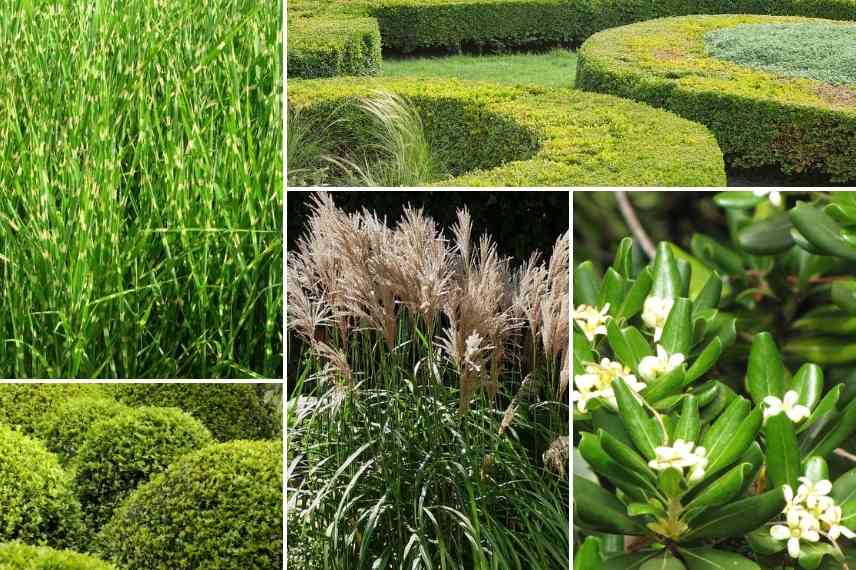
A modern scene where green takes centre stage: Miscanthus ‘Strictus’ and Miscanthus sinensis ‘Malepartus’ join sculpted forms of boxwood and the cushions of Pittosporum ‘Tobira’
Natural gardening
In a natural meadow area within a large garden, well-chosen Miscanthus give the impression of having always been there, and that is truly what is sought in these free, wild spaces. If you plant them along the edge of a wide path, they form a flowing, colourful, abundant route.
Mix varieties with fine foliage that rustles at the slightest breath of wind such as ‘Gracillimus’, varieties a little tousled with an open habit such as Miscanthus nepalensis, tall and natural-looking like ‘Grosse Fontäne’, very free-form like ‘Yaku Jima’. These varieties bring very different flowering tones, from pink to purple. Pair them with some tall perennials that will complement them nicely: Asters, Perovskias, Veronicastrums, Mulleins…
Discover other Miscanthus
View all →Available in 0 sizes
Available in 3 sizes
Available in 1 sizes
Available in 1 sizes
Available in 1 sizes
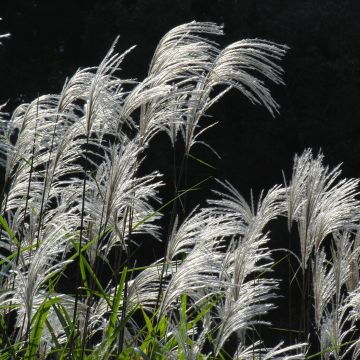
Available in 2 sizes
Available in 2 sizes
Available in 2 sizes
Available in 2 sizes
Available in 3 sizes
In a winter garden
Miscanthus are ideal candidates for slipping into winter garden scenes, or « Winter garden » : their culms and feathery inflorescences remaining in place during cold season, they enliven a winter scene in the most beautiful way with their straw-coloured, parchment-like tones. So poetic when dusted with frost, Miscanthus ‘Silberfeder’, ’Krater’ or ‘Grosse Fontäne’ look magnificent within areas carefully planned for winter: pair with a few contrasting touches such as Cornus alba ‘Sibirica’ or sanguinea with decorative wood that will be superbly showcased, an Acer griseum with sculptural bark and silhouette, and an Hamamelis x intermedia ‘Diane’ with red flowers. A few Stipa arundinacea and Pittosporum ‘Tom Thumb’ will further enhance these warm tones. Chimonanthus praecox will accompany them with its delicate yellow flowering in late winter. Finally, Pinus mugo ‘Winter Gold’ will bring a lovely sheen and brightness to the composition.
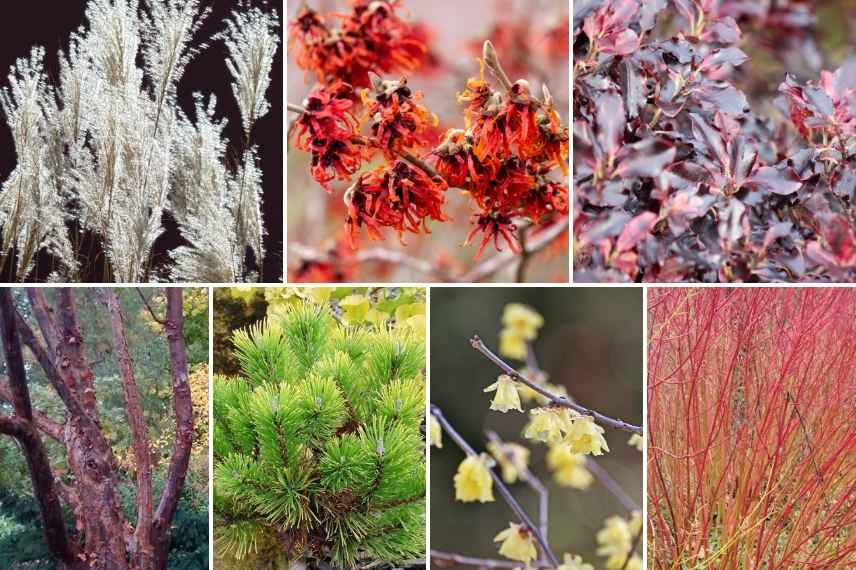
Miscanthus sinensis ‘Silberfeder’, Hamamelis ‘Diane’, Pittosporum ‘Tom Thumb’, Acer griseum, Pinus mugo ‘Winter Gold’, Chimonanthus praecox and Cornus alba sanguinea
Read also
How to choose a Miscanthus?In containers
Some Miscanthus varieties that are medium-sized or remain low can easily enhance your terrace, alongside other potted plants. Just make sure to keep a unifying thread for a harmonious result: by selecting cultivars with broader leaves such as Miscanthus sinensis ‘Cabaret’ or ‘Cosmopolitan’ you achieve an exotic effect. Paired with a Phormium, a Cordyline or a Pennisetum setaceum ‘Rubrum’, Alstroemerias and some cacti hardy enough such as a Hesperaloe (the hardy cousin of agaves), this mini container garden will be sure to catch the eye and transport you!
For a different atmosphere with varieties having ultra-fine foliage, such as ‘Gracillimus’: it’s a more delicate atmosphere you’ll give your terrace with other Miscanthus as light as ‘Arabesque’ and the magnificent ‘Purple Fall’, accompanied by pots of Verbena bonariensis ‘Lollipop’, Agapanthus ‘White Heaven’, and the purple of a Salvia nemorosa.

Cordyline australis ‘Torbay Dazzler, Hesperaloe parvifolia, Miscanthus ‘Cabaret’, Phormium ‘Pink Panther’, Alstroemeria ‘Inca Exotica’
For dry gardens
Miscanthus adapts to all soils, even the driest. Plant them in a sunny spot and complement them with undemanding plants. They will then form the structure of a small dry garden where they will tower over some Euphorbias myrsinites, Hebe rakaiensis, Artemisia, lavenders and some creeping rosemary. These silvery foliage will contrast nicely with the golden culms.
In a more modern dry garden, you can pair them with a single upright conifer (Cupressus sempervirens ‘Garda’) and low cushion forms such as fescues or Carex, a low Pennisetum: play on shapes and colours rather than on flowering to achieve a graphic look.
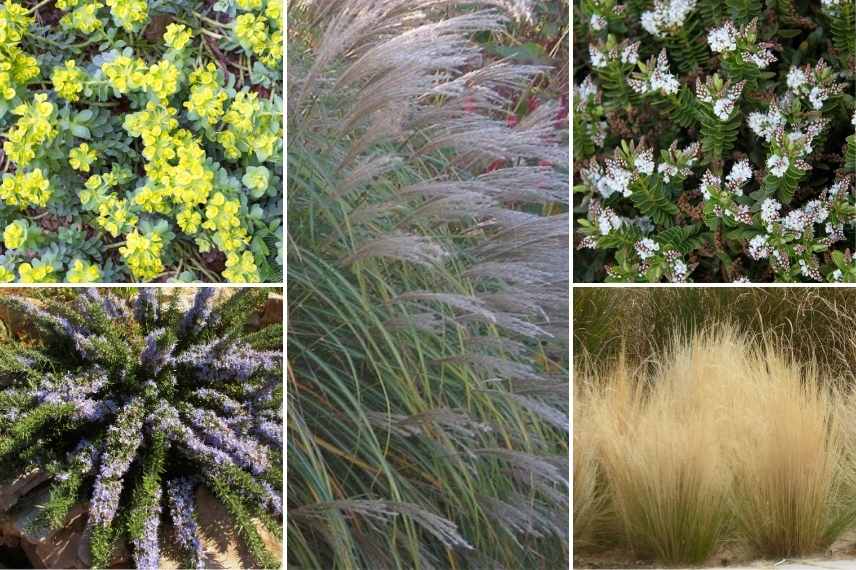
Corsican spurge, creeping rosemary, Miscanthus sinensis ‘Adagio’, Hebe rakaiensis, Stipa tenuissima
By the sea
Miscanthus readily tolerate wind and sea spray, which makes them ideal for seaside gardens: they are wonderful when buffeted by wind, providing controlled rippling and great lightness to the garden. Choose species that grow well in dry, sandy soil: Miscanthus sinensis ‘Kleine Fontäne’ or the variegated ‘Etincelle’. Plant them in groups (at least 3 to 5), and pair them with plants well adapted to seaside conditions and tolerant of salt: Phillyrea angustifolia, Olearias, Gauras, brooms, shrubby veronicas, Artemisia stelleriana ‘Boughton Silver’, Pinus mugo. A few Stipa tenuifolia will provide a golden, rippling mass. Complete the scheme with one or three dwarf palms to contrast with Miscanthus’ suppleness, or with Senecio mandraliscae — the result is surprising!
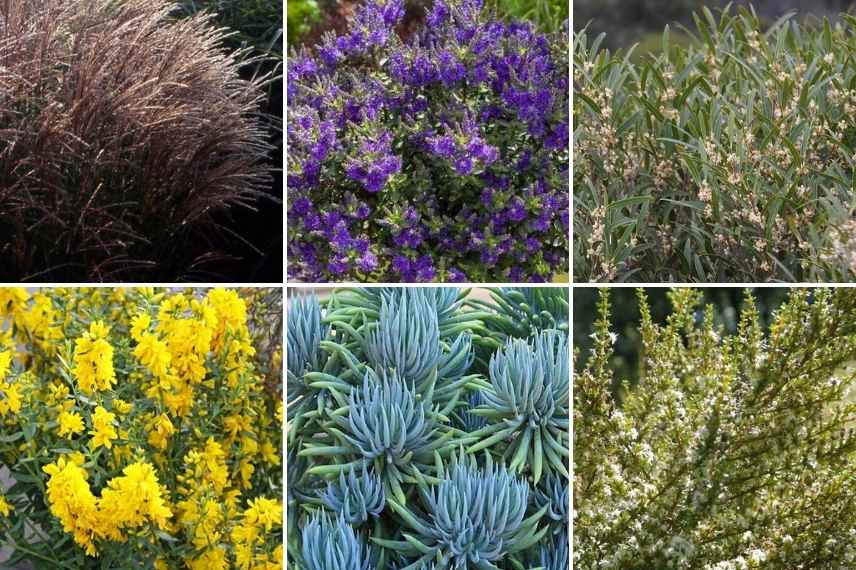
Miscanthus ‘Kleine Fontäne’, Hebe ‘Claret Crush’, Phillyrea angustifolia (Photo: G. van Noord), Genista tinctoria ‘Plena’, Senecio mandraliscae, Olearia solandri ‘Aurea’
In an autumnal scene
Miscanthus magic reveals itself as autumn arrives and as they dress in warm, changing hues, both in their foliage and their inflorescences. This is a characteristic of this grass that is worth using in autumnal displays, with other grasses and perennials enhancing the garden before winter.
Mix a few varieties: ‘Graziella’ with coppery foliage and silvery plumes, ‘Grosse Fontäne’ turning silvery, and ‘Morning Light’ with coppery‑red inflorescences. Plant a few Molinia grasses that flare into colour in autumn. Bluish, pink to orangey tones of Asters ‘Turbinellus’, autumn marguerites, Japanese anemones, Sedums spectabiles, echinaceas will be perfect companions, bringing grace, lightness and softness to this autumnal scene.
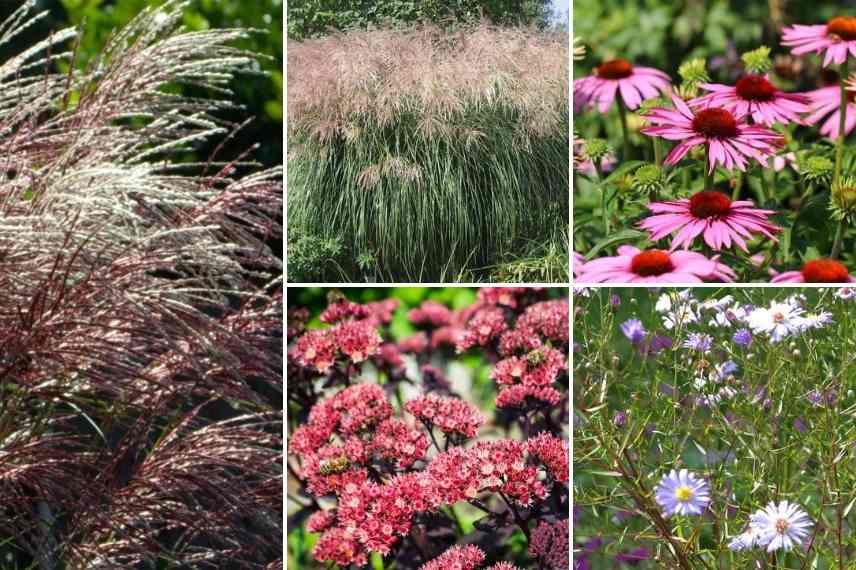
Miscanthus ‘Grosse Fontäne’, Miscanthus ‘Graziella’, Sedum spectabile, Echinacea purpurea, Aster Turbinellus (Photo: Peganum)
In a garden dedicated to ornamental grasses
Capturing light like no other plant, grasses planted together create enchanted gardens of unparalleled grace and lightness. This very fashionable trend can also work in a smaller area of the garden for those who do not wish to dedicate their whole garden to grasses. It is obviously a strong landscaping option when dedicating a large naturalistic garden to grasses!
Miscanthus, because of their size, blend very well with other grasses of the same height or lower, and with different varieties. Do not hesitate to insert a few structural evergreen bushes clipped to precision that will contrast wonderfully with movement of your wild grasses (as at Jardin Plume), or with a few natural perennials, tall, which will highlight your grasses. Masses of Miscanthus sinensis planted together can create a magical scene around a pool or terrace for an almost contemporary effect. In your layout, choose 3 or 5 species, for example of different heights, depending on garden size. In beds, incorporate sparingly some tall perennials (Verbascums, Verbena bonariensis, Echinaceas…), and cushion-forming perennials (heathers, lavenders…) for an interesting visual play, with, for example, Miscanthus ‘Graziella’, ‘Adagio’ and ‘Gracillimus’. Mix in some Panicum virgatum (‘Squaw’, ‘Heavy Metal’) and Calamagrostis Karl ‘Foerster’; a limited mix of varieties is preferable for harmonious effect.
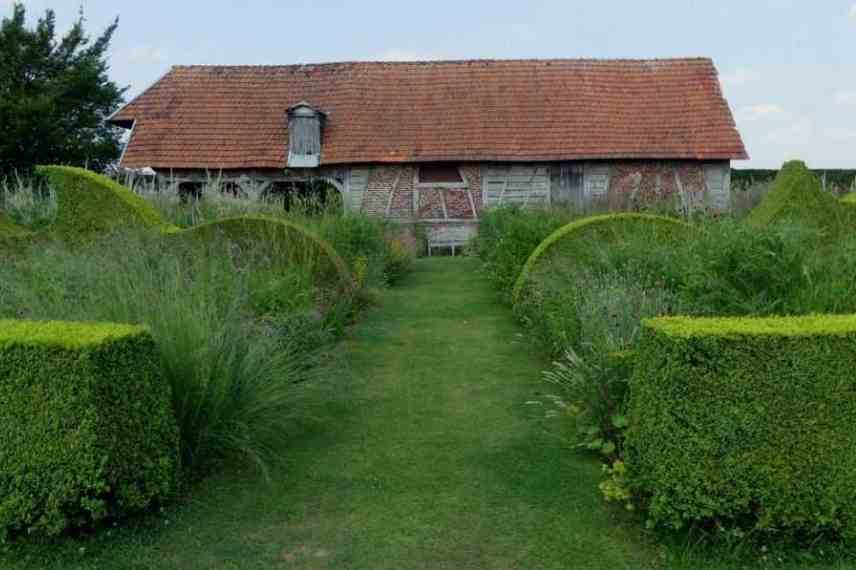
Famous Jardin Plume (Photo: A. Lambert)
→ Also discover Alexandra’s visit to Jardin Plume (Seine-Maritime)
At the edge of a pond
This is not the use that immediately springs to mind, as Miscanthus is often associated with drought and naturalistic planting. Many cultivars originating from marshes in fact perform better in fresh, even damp ground, which widens their scope. However, this ground must be well drained. Plant one or two specimens of Miscanthus sinensis ‘Purpurascens’ or ‘Cabaret’ to act as the showpiece. Combine them with lightweight moisture-loving plants: Persicarias, Schizostylis coccinea ‘Major’, Libertias, purple loosestrife, and other more structural plants to tease the edges of this unusual pond: Darmera peltata, Zantedeschias (arums).
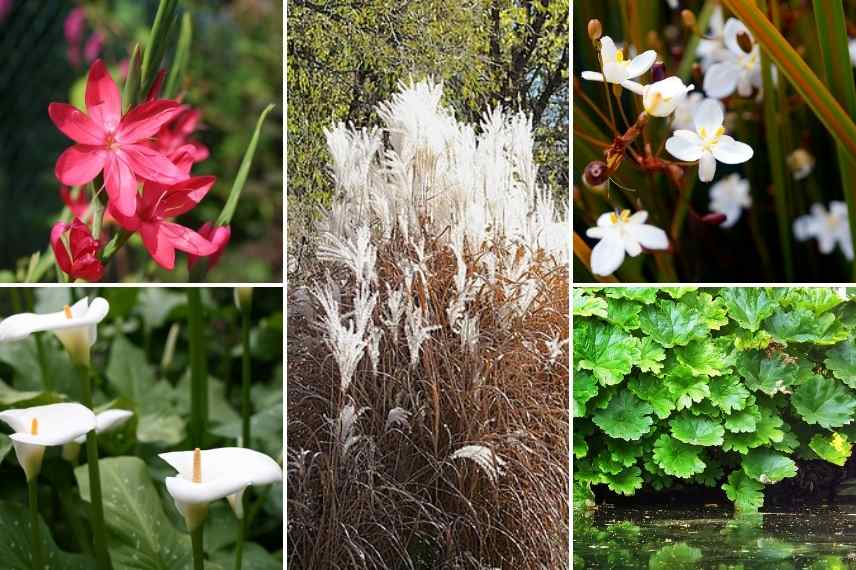
An evocation of a riverbank in this scene featuring: Shizostylis coccinea, Zantedeschias, Miscanthus sinensis ‘Purpurascens’, Libertias peregrinans and Darmeras peltata
- Subscribe!
- Contents
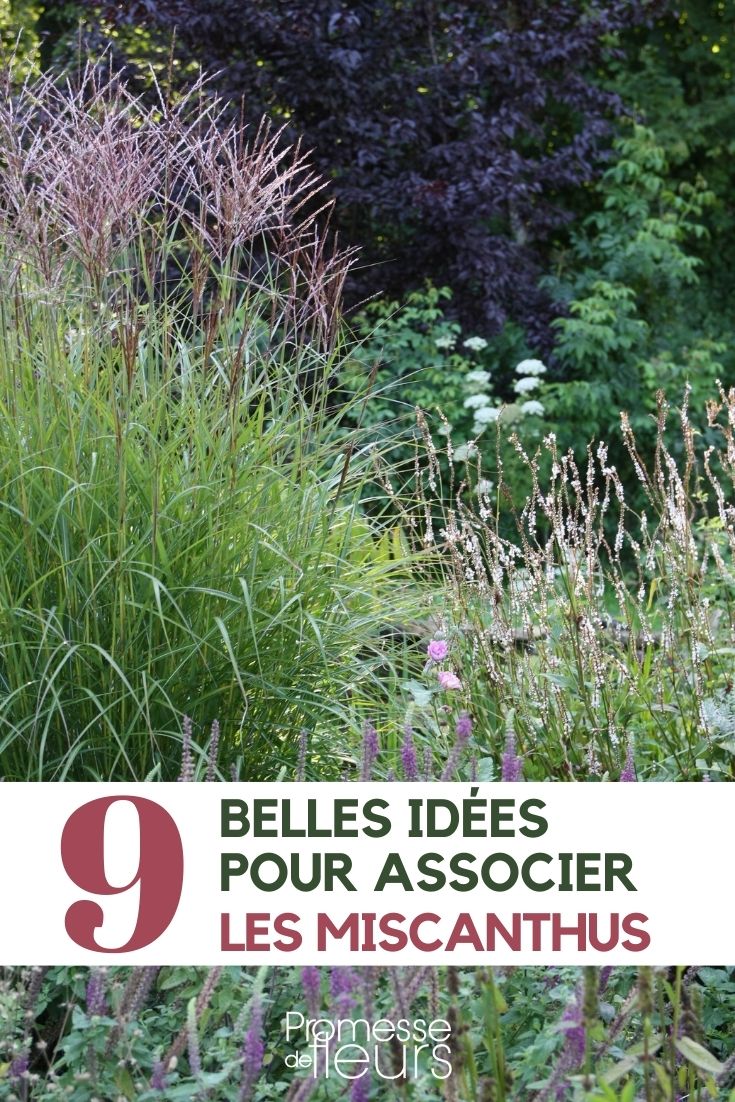
































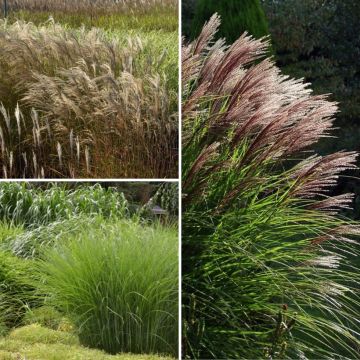
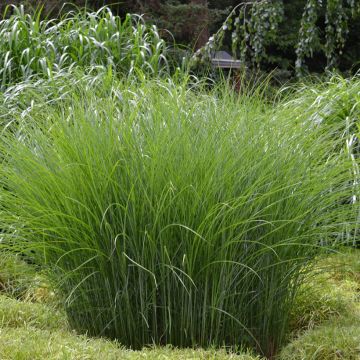
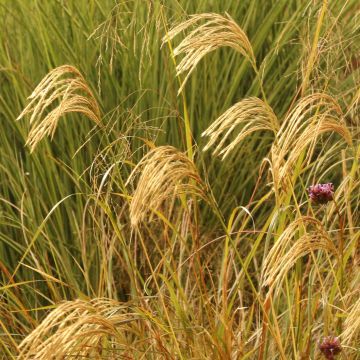
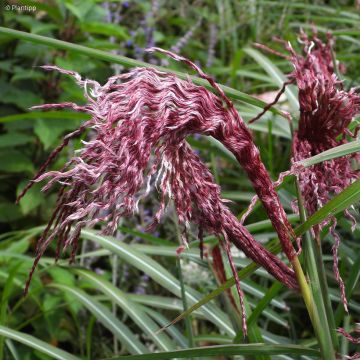
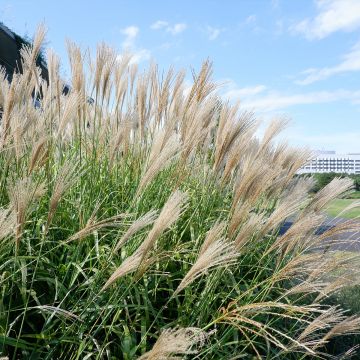
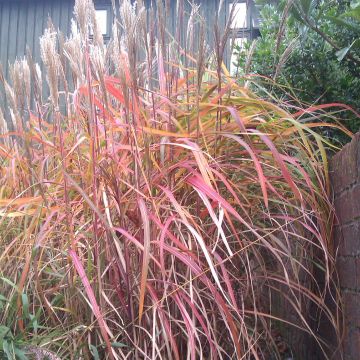

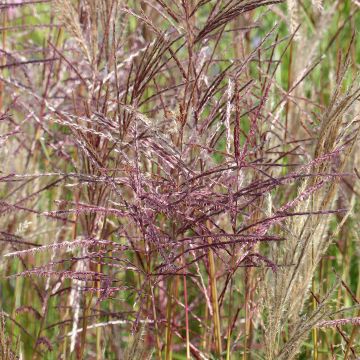
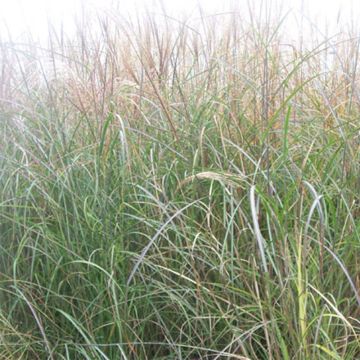
Comments